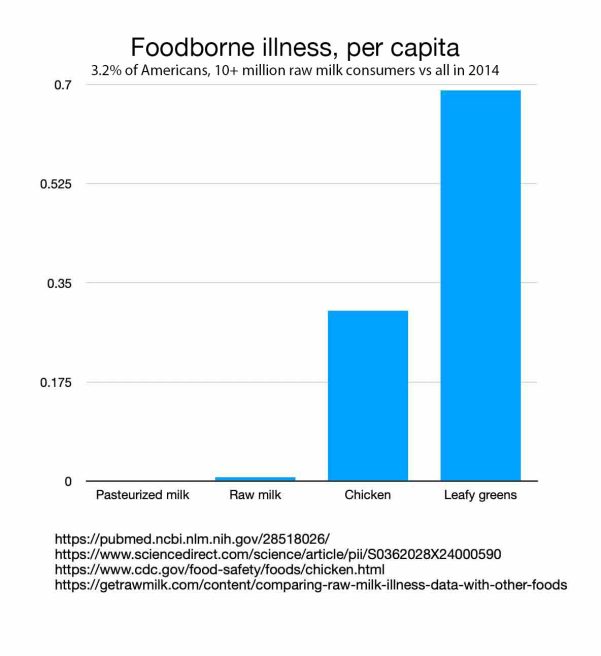Finishing the legalization of raw milk worldwide will require a few things. Good clean milk, for starters. Breaking through the paranoia sowed by industry careerists in media comes next.
Let’s look at a paragraph from Rolling Stone.
Between 2009 and 2014, raw milk and cheese — which are only consumed by 3.2 percent and 1.6 percent of the U.S. population, respectively — are responsible for causing 96 percent of illnesses from dairy contamination, according to a 2017 study in Emerging Infectious Diseases, a peer-reviewed journal published by the Centers for Disease Control and Prevention (CDC).
While it’s loudly stated and frequently posted that 96% of milk-related illnesses are caused by raw milk, with only 4% caused by pasteurized milk, both numbers are microscopic. Getting sick from raw milk is not common, and does not occur at a rate that exceeds other commonly eaten foods.
The disagreement is not whether a risk exists or not, but whether or not the occurrence of foodborne illness related to raw milk qualifies as too risky and deserving of exclusion. Growth in the market of raw milk demonstrates that many people, who were all taught that pasteurization is necessary, do not find a sense of urgency in the real life experience of consuming raw milk or the official numbers.
So, let’s look at some data.
How many people get sick from raw milk?
In recent legislative hearings, numbers were brought by opponents to the legalization to raw milk. Commissioner Mike Strain of Louisiana stated (pubmed) that 3.2% of the US population consumes raw milk – greater than 10 million people – as of 2014. He goes on to state that 761 get sick per year, with 22 cases requiring hospitalization, and no deaths.
That’s a 1 in 14,250 (or 0.007%) risk of getting something as mild as a stomach ache, and a 1 in 500,000 (or 0.0002%) risk of needing to visit a hospital, death doesn’t seem to be on the table without comorbidity and doesn’t happen often.
These numbers are spread across all farms. Modernized and sanitized farming operations, high performing, low performing, and the most rustic cottage industry offerings all get thrown into the same dataset. Identifiable sanitation errors in production lead to virtually all cases where illness can be conclusively attributed to a raw milk product. If a person is healthy and consuming raw milk from a clean source, the personal risk is assumably lower than the data above.

Comparing the illness rates of raw milk and leafy greens
Leafy greens sicken more people than raw milk. This is not only due to the fact that more people eat leafy greens, but also the rate at which leafy greens sicken people.
Leafy greens cause 9.8% of foodborne illness in the United States each year, with an estimated 2.3 million people affected. If we assumed that 333 million people are consuming leafy greens, or the entirety of the US population, the rate of illness per consumer associated to leafy greens is 0.69%.
0.69% of leafy green consumers get sick from leafy greens.
0.007% of raw milk consumers get sick from raw milk.
A person who consumes raw milk and lettuce is nearly 100 times more likely to get sick from the lettuce.
Are raw milk related illnesses worse? Not if both raw milk and lettuce are suspected to carry the same pathogens like Escherichia coli O157:H7, Salmonella, Listeria, etc. Hemolytic uremic syndrome can come from any food, because the bug is independent from the food, which is the base concept of germ theory. Plant-based imitation milks contributed to the deaths of two people in August 2024, reminding us that the illnesses attributed to raw milk are not uniquely dangerous – as these same pathogens can be delivered by foods other than raw milk.
Comparing the illness rates of raw milk and chicken
CDC estimates that every year in the United States about 1 million people get sick from eating contaminated poultry.
Let’s assume all 333,000,000 people in America consume chicken. 1,000,000 of 333,000,000 people represents a 0.3003% real occurrence of foodborne illness among chicken consumers, per consumer.
0.3003% of chicken consumers get sick from chicken, while 0.007% of raw milk consumers get sick from raw milk.
Raw oysters and vibriosis
From foodsafety.gov:
Vibriosis is an illness caused by some kinds of Vibrio bacteria. Vibrio naturally live in coastal waters where oysters live. Because oysters feed by filtering water, Vibrio and other harmful germs can concentrate in an oyster’s tissues. If you eat raw or undercooked oysters, germs that might be in the oyster can make you sick.
CDC estimates that about 80,000 people get vibriosis—and 100 people die from it—in the United States every year.
Out of 35,000,000 oyster eaters per year, 1 in 438 get sick. 0.00029% of oyster shucks are deadly.
Raw milk farmers are keeping it clean
Nobody wants to get sick, or make anyone sick with their food or recommendations. These low numbers do not justify throwing caution to the wind or failing to combat harmful contamination, bugs or otherwise, but they also don’t warrant the anxiety promoted on social and legacy media.
While skepticism is understandable, considering the sheer amount of biased media hype driven by industry, but the data itself shows us that raw milk farmers are doing a great job keeping things clean.
